As an Amazon Associate I earn from qualifying purchases.
This bavette steak recipe is absolutely perfect for grilling, or cooking in a screaming hot cast iron skillet. It's an amazing cut of beef because it's super flavorful, and we're going to make sure that it comes out beautifully tender by cooking it properly (which means a meat thermometer).
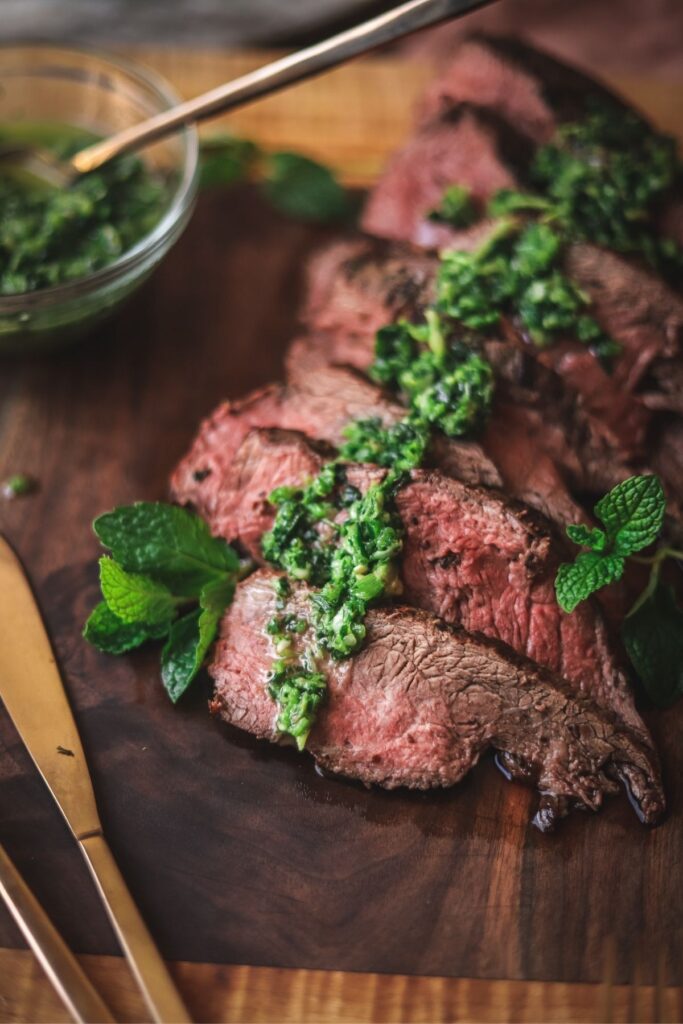
We'll go into exactly what bavette steak is in just a second, but it's a cut of meat that's super economical and also tasty! It's similar to a flank steak in all the different ways you can prepare it, you just don't necessarily have to marinate it. It's both a weeknight dinner, and one you can pull out to impress guests.
Check out the web story here.
Bavette steak is going to be your new favorite cut of beef. It's so flavorful, and very tender, so it doesn't need to marinate for long periods of time!
Jump to:
Why You're Going to Love this Recipe
- Bavette steak, also known as flap steak or sirloin flap, is super delicious because it's a very flavorful cut of beef.
- It's also super tender, making it great for grilling or pan searing.
- You don't have to marinate it (I suggest it in this recipe, but you could totally skip this step if you want).
- It's really versatile, flavor wise. We're going with something a bit spicy here, but a classic chimichurri would work, and a Romesco sauce would also be fantastic.
What is Bavette Steak?
Bavette steak is is a long, flat, and triangular cut that comes from the bottom sirloin, and it's wedged just in-between the sirloin and the flank.
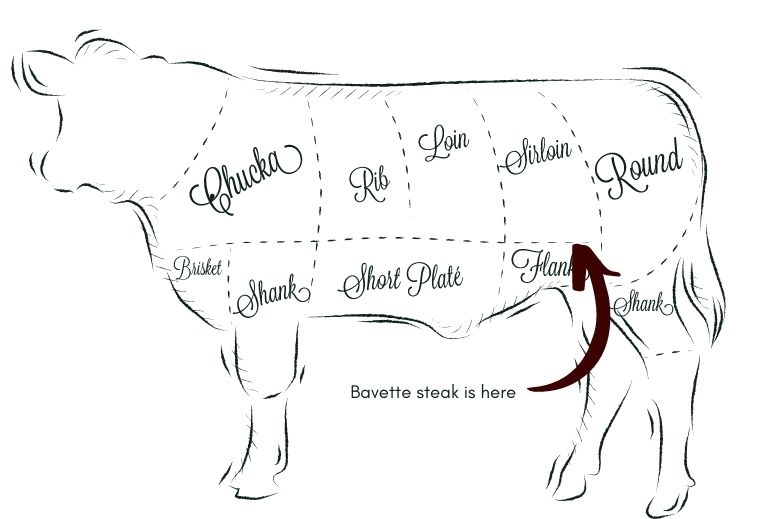
This cut, while also called a flap steak, is commonly mistaken for hanger steak or flank steak, but it's definitely not the same thing. The bavette steak is different in shape, and the muscle fibers and graining are much looser than on a flank steak, meaning you can get a away without marinating it (super flavorful and tender? Count me in!).
Is it Different from Flank Steak?
Alright, so flank steak and bavette steak are both cuts of beef that come from the same general area of the cow, but they're just a little bit different.
Flank steak is a little bit leaner than bavette steak and comes from the lower chest of the cow. It's a long, thin cut of beef that has a lot of flavor, but can be a bit tough if it's not cooked properly. It's usually sliced thin against the grain for serving and it's great for dishes like fajitas and stir-fries.
Bavette steak, on the other hand, comes from the area near the flank, right next to the sirloin. It's a little bit thicker than flank steak and has a lot more marbling, which means it's got a lot of fat running through it. This makes it really tender and super delicious, but also makes it a little bit more expensive than flank steak. It's generally cooked by searing or grilling and it's perfect for simple preparation, letting the natural flavor of the meat shine through.
So, they're both tasty cuts of beef, but bavette steak is a little bit more fancy and flavorful, and flank steak is a little bit more versatile and leaner.
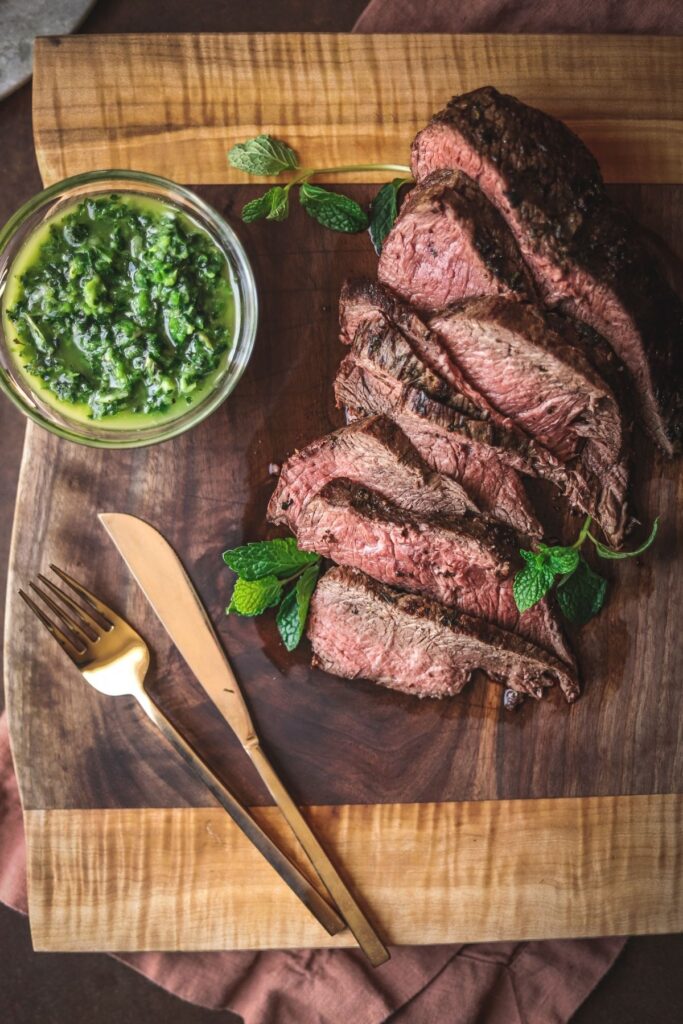
Where can you Buy It?
I've found that it's definitely not a common cut you can find in most grocery stores. I've always had luck though, at my local specialty butcher's, who not only have it, but are great sources of information on what it is and how to cook it.
Ingredients
For the Steak
This is an easy list. You just need the steak! One steak will feed up to four people, as they're quite large. Add some salt and pepper to season, and you're good to go. The chimichurri marinade is where we need to get a few more ingredients.
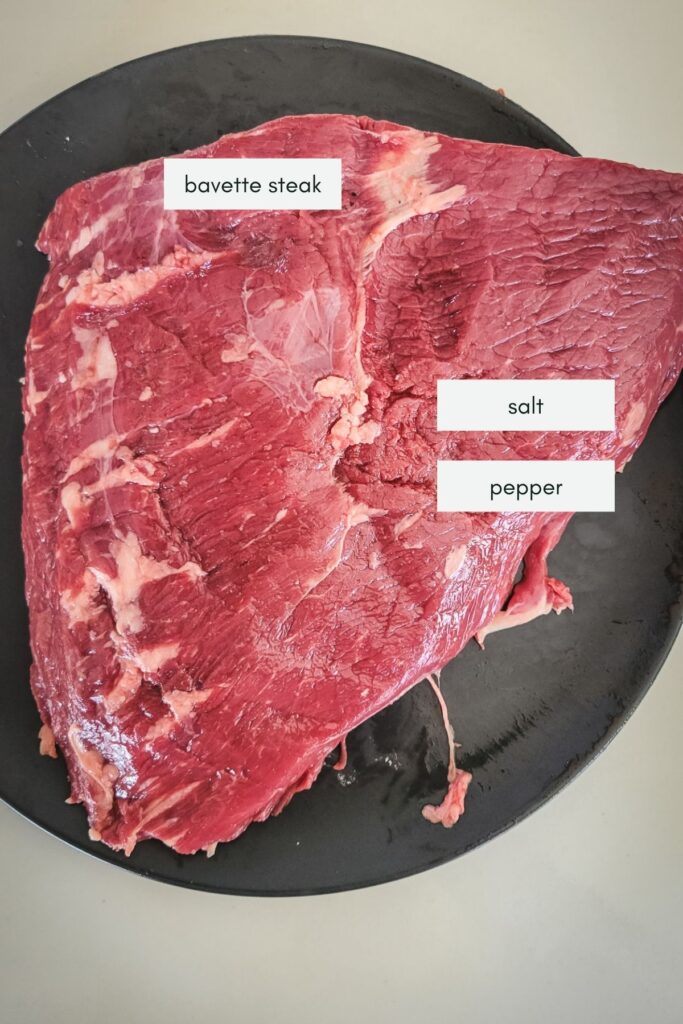
For the Chimichurri Marinade
This is definitely a bit of a different take on chimichurri - and if you have a different favorite recipe, then go ahead and use it! I love the flavor that the poblano and jalapeno bring to this dish though.
- Poblano and jalapeno peppers for some unexpected flavor and spicy kick
- Neutral flavored oil to bring it all together
- Shallots and garlic for flavor
- Lemon for brightness
- Fresh mint and cilantro for freshness
- Fresh oregano for some balancing earthy flavor
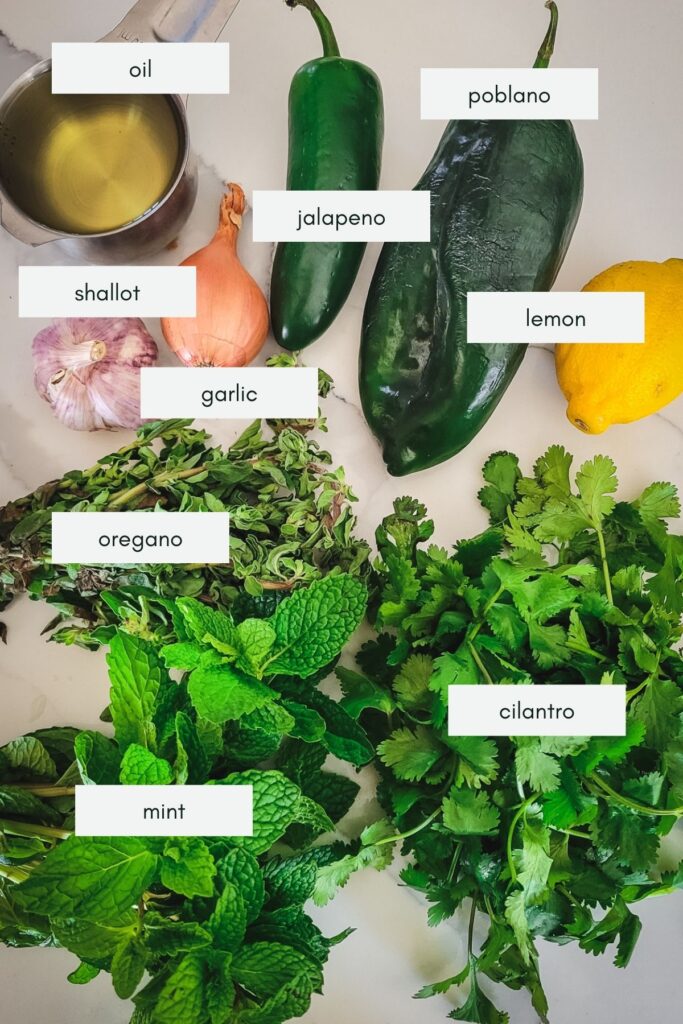
How to Cook the Bavette Steak
Before we start cooking the steak, you can marinate it for a few hours if you want, but you don't have too. One of the best parts about this steak is that it's tender, so it's not necessary to marinate it like it would be say, a flank steak. However, the marinade definitely helps with the flavor, so if you have time, go for it!
So, first things first, let's make the chimichurri marinade. It takes about five minutes, and comes together in a blender, so it really could not be easier!
- First, we're going to add all of our ingredients, except the oil to a blender. Blend it on a low speed so the peppers, herbs and garlic all get chopped, but don't get too smooth (you sort of want a fine chop on everything, not a blend).
- Add the oil, and then blend just enough to mix.
- Spread the chimichurri over the entire bavette steak, and season it with salt and pepper as you go.
- Cover, and marinate between 4-12 hours in the fridge. Let it come up to room temperature before you want to cook it.
- Heat up your cast iron, or your grill. If you're using a cast iron, also preheat your oven to 400 F. Throw a little oil in the pan, and then hit the pan with the steak. Sear for 3-4 minutes on each side, and then transfer the entire thing to the oven. Cook for 15-20 minutes, until it reaches an internal temperature of 115 F. Let it rest for 10 minutes, and then slice, topping it with the chimichurri. For the grill - put in on the grill on medium-high heat. Cook for 8-12 minutes per side, until the internal temperature hits 115. Take it off, rest for 15 minutes, then slice and top with chimichurri.
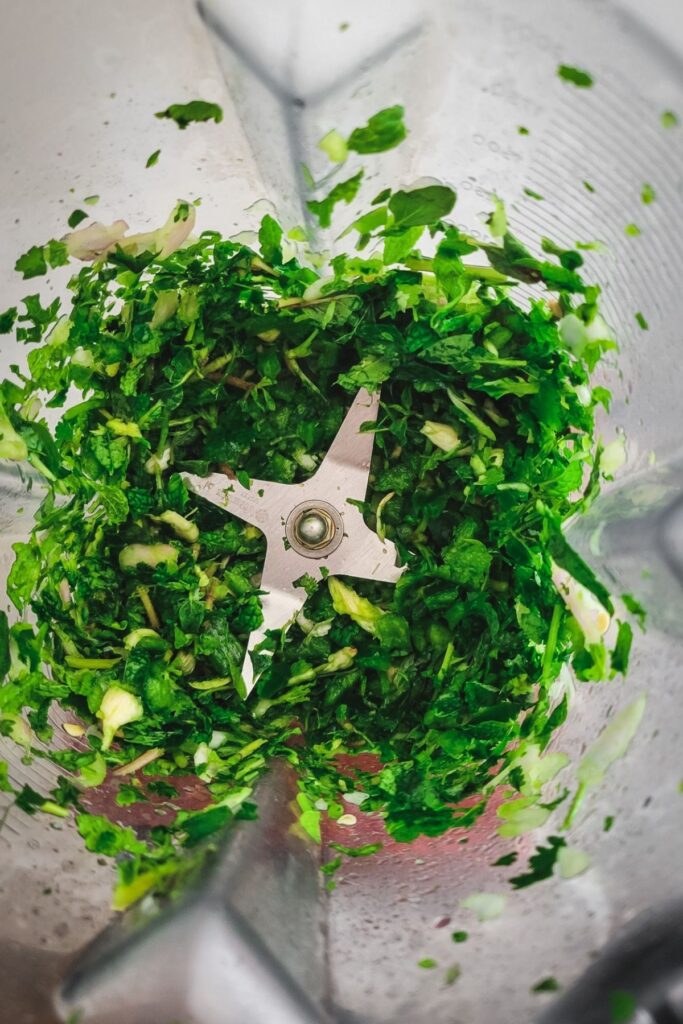
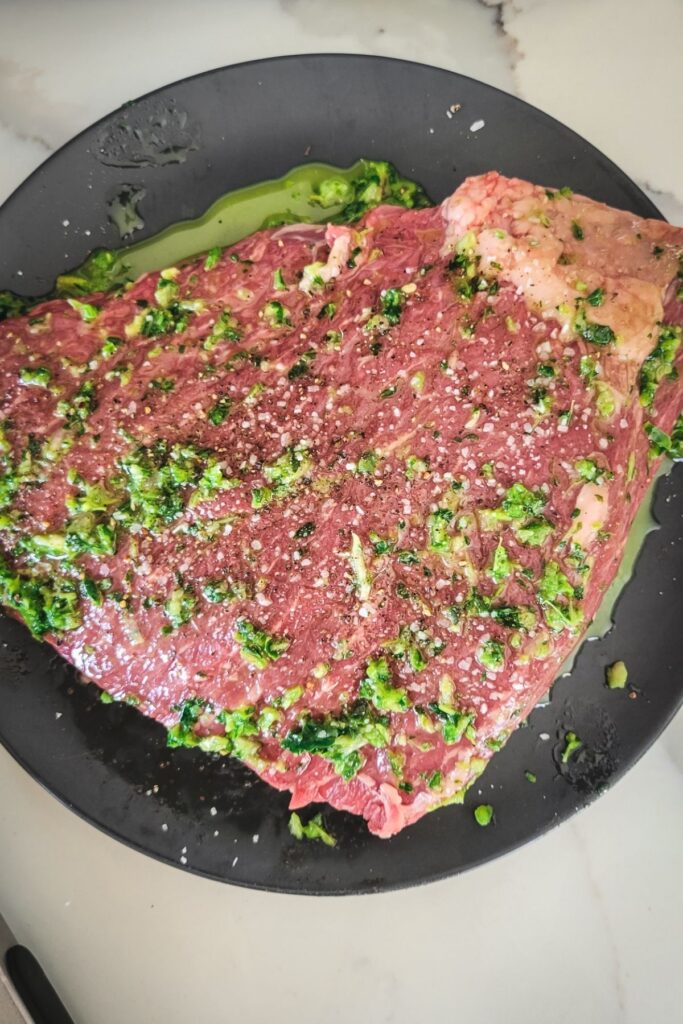
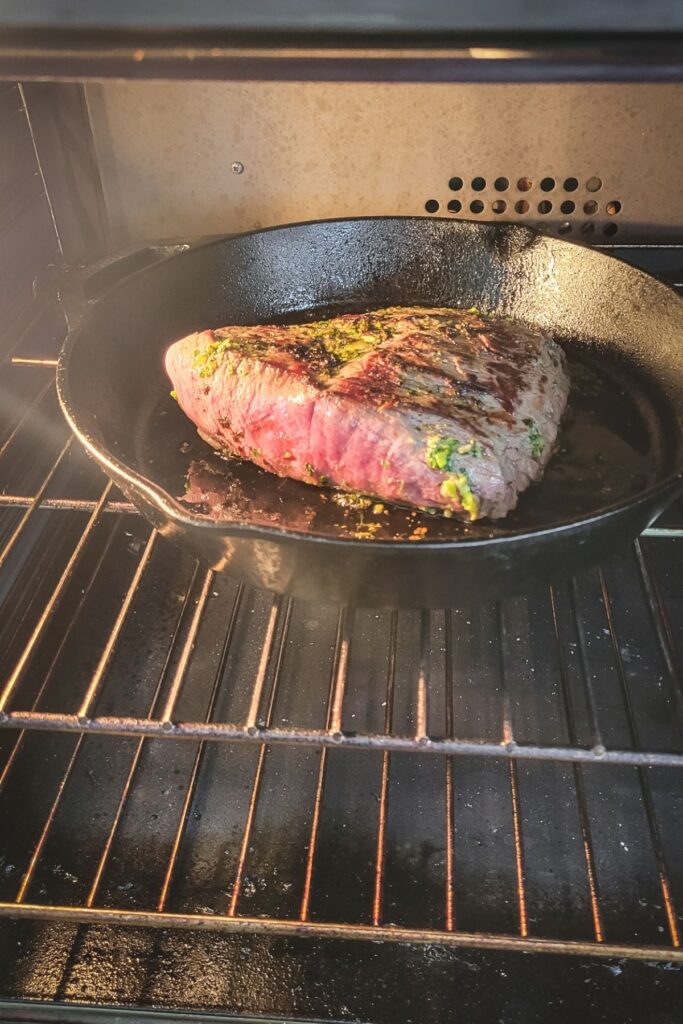
Internal Temperatures for Bavette Steak
Here's what your meat thermometer needs to read for the different levels of doneness:
- Rare: 120-125°F (48-52°C)
- Medium-rare: 130-135°F (54-57°C)
- Medium: 140-145°F (60-63°C)
- Medium-well: 150-155°F (65-68°C)
- Well-done: 160°F (71°C) or higher
It's important to keep in mind that these are guidelines, and the ideal temperature may vary depending on personal preference.
It is also important to take note that bavette steak has a thick muscle fibers, and so it will be most tender and flavorful when cooked to medium-rare or medium. Cooking it well done may make the meat dry and less juicy.
How to Slice It
Slicing a bavette steak can be a little bit tricky because it's got a thick muscle running through it, but once you know the right technique, it's super easy.
First thing, you want to make sure that your steak is rested for a few minutes before slicing. This allows the juices to redistribute and ensures that the steak will be nice and juicy.
When you're ready to slice it, the key is to slice against the grain. This means you want to slice perpendicular to the lines of muscle fibers. This helps to break down the fibers and make the steak more tender.
Here's what to do:
- Look for the direction of the muscle fibers (the lines running through the steak)
- Hold your knife at a 45-degree angle to the cutting board
- Slice the steak against the grain, cutting into thin strips
- Repeat until you've sliced the entire steak
Keep in mind that the slicing should be thin enough to make the meat tender. When slicing a bavette steak, you want to aim for pieces that are about ¼ inch thick. This will make it easy to chew and enjoy the great flavor of the steak.
Also, if you feel that you're having trouble slicing through the thick muscle, use a sharp knife and apply more pressure.
Tips & Tricks
Dry the steak: Before cooking the steak, make sure it's dry by patting it with paper towels. Moisture on the surface of the steak will prevent a good sear from forming, which is key for a delicious crust.
Season it up: Season the steak generously with salt and pepper on both sides. This will help to bring out the beefy flavor of the steak and make it taste even better.
Heat it up: Make sure your pan, grill or broiler is hot before adding the steak. High heat will help to create a nice crust on the outside while keeping the inside tender and juicy.
Don't move it around: Once you've put the steak on the heat, don't touch it or move it around. Let it cook on one side undisturbed for a couple of minutes before flipping it over. This will help to prevent the steak from sticking to the pan or grill and will make it easier to get a nice crust.
Rest it: After cooking the steak, let it rest for a few minutes before slicing into it. This will allow the juices to redistribute throughout the steak and make it more juicy and flavorful.
Slice it properly: When you're ready to slice the steak, make sure to slice it against the grain. This will help to make it more tender and easier to chew.
Pair it up: Bavette steak pairs well with robust wine, bold reds such as Malbec, Syrah/Shiraz and even a big buttery Chardonnay will match perfectly with its beefy flavor, you could also try it with a dry and aromatic rosé.
How to Serve it
This steak is so versatile, you can try it (and this chimichurri marinade) grilled or as steak fajitas. Here's what I'm serving alongside it:
- Raw Oysters with Fresh and Spicy Tomatillo Habanero Mignonette
- Grilled Peach and Burrata Salad with Honey
- The Best Crispy Truffle Parmesan Fries with Homemade Aioli
- Homemade Caesar Salad Dressing
- Arugula Pesto Pasta with Almonds and Burrata
Wine Pairing
If you're looking to pair a wine with your bavette steak, you've got a few options that would be delish.
If you like a nice red wine, a good choice would be a Malbec or a Syrah/Shiraz. These wines have bold, rich flavors that will complement the beefy taste of the bavette steak perfectly. They both have nice tannins and acidity to cut through the fat of the steak and bring out the flavors of the meat.
If you're more of a white wine person, try a big, buttery Chardonnay. The rich, oaky flavor of the wine will pair well with the steak, and the butteriness will help balance out the boldness of the meat.
Another alternative would be to pick a dry and aromatic rosé. Rosés can be made from a variety of grapes, but they all tend to be light-bodied and crisp which make them great for cutting through the fat of the bavette steak.
When it comes to wine and steak, always remember, it's all about finding a balance between the flavors and textures of the wine and the meat. So, pick a wine that you like and you can't go wrong.
FAQ's
Bavette steak is a cut that comes from the bottom sirloin. It's often confused with flank steak, and although similar, they are different. Flank steak has a much tighter grain, and therefore is tougher, needing to marinate for hours. Bavette can be marinated, but it's much more tender, so it's mostly for added flavor.
Medium-rare: take it off the heat when it hits 115 F. It should come up to 125-130 F after it rests.
Medium: take it off the heat at 125 F. You're aiming for a temperature of 140 F after resting.
Medium-well: take it off the heat at 140 F. Aiming for 150-155 F.
Well: pull it off the heat at 160 F. Aiming for internal temperature of 170 F after resting.
Definitely on high heat in a cast iron or on a grill. For the cast iron, you can finish it in the oven. It also makes great fajitas!
Bavette steak, also known as flap steak or sirloin flap, is super delicious because it's a very flavorful cut of beef. It comes from the area near the flank, which is a well-used muscle, so it's got a lot of beefy taste. Plus, it's got a decent amount of fat running through it, which adds to the flavor and makes it really tender.
Other Awesome Beef Entrees
📖 Recipe
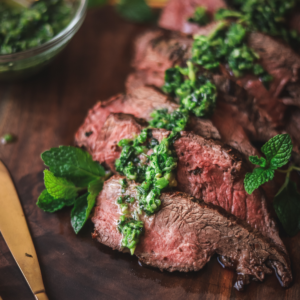
Bavette Steak with Poblano Chimichurri
Equipment
- Cast Iron Skillet
- Grill
Ingredients
- 1 3-4 lb bavette steak fat cap removed
- ½ teaspoon salt
- ¼ teaspoon pepper
- ½ poblano pepper
- ½ jalapeno pepper
- 3 cloves garlic
- 1 shallot
- ½ C mint leaves fresh
- ⅓ C oregano leaves fresh
- 1 C cilantro leaves and stems
- 2 tablespoon lemon juice
- ¾ C vegetable oil
- salt and pepper to taste
- 1 tablespoon oil for cooking
Instructions
- Preheat your oven to 400°F, or your grill to medium high heat.
- Take the steak out of the fridge about 30 minutes before you cook it. This will allow it to come up to room temperature, and be easier to cook.
- Season the stake liberally with salt and pepper. Set aside.
- In a blender, combine the peppers, herbs, garlic, shallots and lemon juice. Blend until they resemble a fine chop. Add the vegetable oil and salt and pepper, and then blend again until just combined (you don't want the chimichurri to look smooth).
- Spread a couple of spoonful's of the chimichurri all over the steak - being careful not to cross-contaminate the chimichurri, because we're using it again later. At this point, you can marinate the steak if you choose for four hours to add more flavor.
- Heat a cast iron skillet over medium high heat. Add a tablespoon of oil to the pan, and sear the steak on both sides (about 3-4 minutes). After that, put it in the oven for 15-20 minutes, until the internal temperature reaches 115°F (for medium rare).
- For the grill, put the steak on the grill, and cook for 10-12 minutes per side, until it reaches an internal temperature of 115°F (for medium rare).
- Take the steak off the heat, and let it rest for 10 minutes. Slice it thinly against the grain, and serve with more chimichurri.
Video
Notes
Nutrition
Jump to:
Hi, I'm Cara! I'm a food writer, journalist, and recipe developer. I'm obsessed good food, good wine, good cocktails and entertaining. I've picked up a few tips over the years, and love sharing them with others.


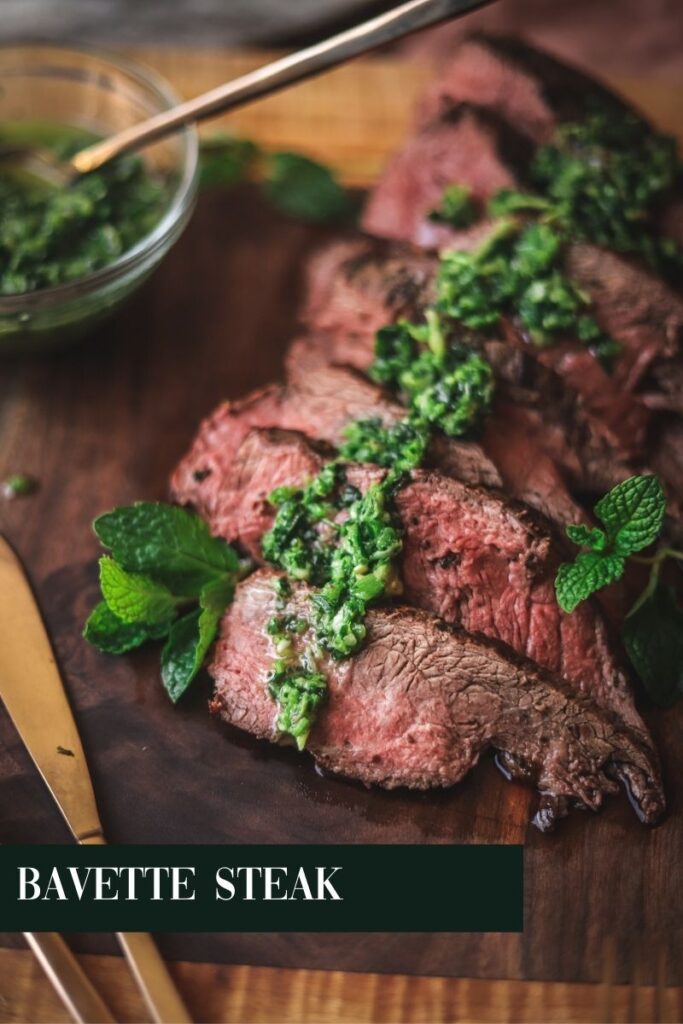
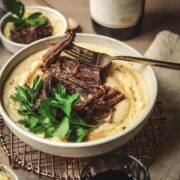

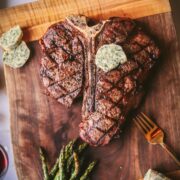


Jill says
Gorgeous! I love chimichurri with steak, although I haven't made it with poblano before. Adding your recipe to our meal plan for next week!
Cara says
Woohoo! Let me know how it goes!
Casey says
The chimicuhurri is AMAZING! I used it over grilled flank steak b/c I couldn't find Bavette, but I am going to keep looking for this cut--it sounds awesome!!!
Cara says
Flank steak is a great substitute, I'm so glad you loved the chimichurri!
Tayler Ross says
We had this steak for dinner last night and omg was it delicious! Thanks so much for sharing the recipe!
Cara says
Thanks so much Tayler, I'm so glad!
Andrea says
Thanks for the education on bavette steak! I hadn't known what it was before. This looks absolutely delicious. Can't wait to try!
Cara says
It's so good, I can't wait for you to try!
Amanda | The Kitcheneer says
This recipe is amazing! And I learned something new about bavette steak!
Cara says
Thanks Amanda, I'm so glad!
Shadi Hasanzadenemati says
Thank you so much! The flavors are perfect and I can’t wait to try this recipe!
Renee B says
Thanks so much for all the background info about bavette steak: it is a totally new cut to me, and I can't wait to try it. In the meantime, your poblano chimicuhurri recipe is spot-on delish! Thank you!
Cara says
I'm so glad you found it helpful Renee!
Luci Petlack says
This was delicious! Definitely a new family favorite.
Cara says
Amazing, thanks so much Luci!
Gina says
It warmed up a little hear so we decided to grill this up and we enjoyed it so much! Made for one great dinner. Yum!
Cara says
Amazing! I totally break out the grill at any time of year as well 🙂
Anjali says
This looks so hearty and flavorful! Love the idea of pairing chimichurri with steak! Yum!
Cara says
Thanks so much Anjali!
Sandra says
What a great recipe! The flavors look perfect and I'm adding it to my menu for this week!
Cara says
Thanks so much Sandra!
Quynh says
Delicious! The steak is perfectly cooked, and I love the chimichurri sauce that goes with it.
Cara says
YAY! I'm so glad Quynh!
Sharon says
This steak comes out perfectly cooked and then the addition of the homemade chimichurri makes a perfect dinner combination.
Cara says
Thank you so much Sharon!
Tayler says
I made this steak for dinner last night and it was incredible! The chimichurri sent it over the top!
Cara says
Woohoo! Thanks Tayler!
Beth says
There is nothing better than a perfectly done steak with a bright chimichurri. We really loved this recipe. Thanks!
Cara says
Thank you so much Beth! I'm so glad you enjoyed it!